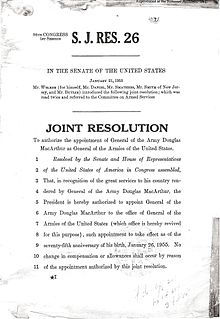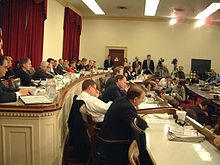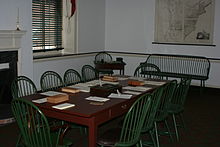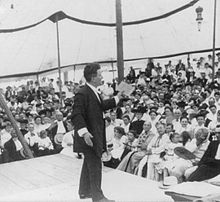- United States congressional committee
-
"House committee" redirects here. For the committee of the House of Lords, see House Committee (House of Lords).
A congressional committee is a legislative sub-organization in the United States Congress that handles a specific duty (rather than the general duties of Congress). Committee membership enables members to develop specialized knowledge of the matters under their jurisdiction. As "little legislatures," committees monitor on-going governmental operations, identify issues suitable for legislative review, gather and evaluate information, and recommend courses of action to their parent body. Woodrow Wilson once said, "… it is not far from the truth to say that Congress in session is Congress on public exhibition, whilst Congress in its committee rooms is Congress at work."[1] It is neither expected nor possible that a member of Congress be an expert on all matters and subject areas that come before Congress.[2] Congressional committees provide invaluable informational services to Congress by investigating and reporting about specialized subjects.
Congress divides its legislative, oversight, and internal administrative tasks among approximately 200 committees and subcommittees. Within assigned areas, these functional subunits gather information; compare and evaluate legislative alternatives; identify policy problems and propose solutions; select, determine, and report measures for full chamber consideration; monitor executive branch performance (oversight); and investigate allegations of wrongdoing.[3] While this investigatory function is important, procedures such as the House discharge petition process (the process of bringing a bill onto the floor without a committee report or mandatory consent from its leadership) are so difficult to implement that committee jurisdiction over particular subject matter of bills has expanded into semi-autonomous power. Of the 73 discharge petitions submitted to the full House from 1995 through 2007, only one was successful in securing a definitive yea-or-nay vote for a bill.[4]
Since 1761, the growing autonomy of committees has fragmented the power of each congressional chamber as a unit. This centrifugal dispersion of power has, without doubt, weakened the Legislative Branch relative to the other branches of the federal government, i.e., the Executive Branch, the courts, and the bureaucracy. In his often cited article History of the House of Representatives, written in 1961, American scholar George B. Galloway (1898–1967) said: "In practice, Congress functions not as a unified institution, but as a collection of semi-autonomous committees that seldom act in unison." Galloway went on to cite committee autonomy as a factor interfering with the adoption of a coherent legislative program.[5] That autonomy remains a characteristic feature of the committee system in Congress today.
Contents
History
In 1931, a reform movement temporarily reduced the number of signatures required on discharge petitions in the U.S. House of Representatives from a constitutional majority of 218 down to 145, i.e., from one-half to one-third of the House membership. This reform was abolished in a 1935 counterattack led by the intra-House oligarchy.[6] Thus the era of the Great Depression marks the last across-the-board change, albeit a short-lived one, in the autonomy of House standing committees.[7] On strategy for an enduring reform in the system of semi-autonomous committees see the citation.[8]
The modern committee structure stems from the Legislative Reorganization Act of 1946, the first and most ambitious restructuring of the standing committee system since the committee system was first developed. The 1946 act reduced the number of House committees from 48 to 19 and the number of Senate committees from 33 to 15. Jurisdictions of all committee were codified by rule in their respective chambers, which helped consolidate or eliminate many existing committees and minimize jurisdictional conflicts.
The Joint Committee on the Organization of Congress, a temporary committee established in 1993 to conduct a policy and historical analysis of the committee system, determined that while the 1946 Act was instrumental in streamlining the committee system, it did fail to limit the number of subcommittees allowed on any one committee. Today, Rules in the U.S. House of Representatives generally limit each full committee to five subcommittees, with the exception of Appropriations (12 subcommittees), Armed Services (7), Foreign Affairs (7), and Transportation and Infrastructure (6).[9] There are no limits on the number of subcommittees in the U.S. Senate.
Congress has convened several other temporary review committees to analyze and make recommendations on ways to reform and improve the committee system. For example, the Legislative Reorganization Act of 1970 led to further reforms to open Congress to further public visibility, strengthen its decision-making capacities, and augment minority rights. The 1970 Act provided for recorded teller votes in the House's Committee of the Whole; allowed minority party committee members to call their own witnesses during a day of hearings; established the Senate Committee on Veterans' Affairs; and enhanced the research capabilities of two legislative support agencies: the Congressional Research Service and the General Accounting Office.
Senate committees
 After committee deliberation, the Senate passed a joint resolution in 1955 authorizing Army General Douglas MacArthur to the post of General of the Armies of the United States.
After committee deliberation, the Senate passed a joint resolution in 1955 authorizing Army General Douglas MacArthur to the post of General of the Armies of the United States.
The first Senate committee was established April 7, 1789, to draw up Senate rules of procedure. In those early days, the Senate operated with temporary select committees, which were responsive to the entire Senate, with the full Senate selecting their jurisdiction and membership. This system provided a great deal of flexibility, as if one committee proved unresponsive, another could be established in its place. The Senate could also forgo committee referral for actions on legislation or presidential nominations. These early committees generally consisted of three members for routine business and five members for more important issues. The largest committee established during the 1st Congress had eleven members, and was created to determine salaries of the president and vice president. Also in the first session, the entire membership of the Senate was divided into two large committees, with half the senators on the committee to prepare legislation establishing the federal judiciary and the other half on the committee to define the punishment of crimes against the United States.
Over time, this system proved ineffective, so in 1816 the Senate adopted a formal system of 11 standing committees with five members each. Three of those committees, the Finance, Foreign Relations and the Judiciary Committees exist largely unchanged today, while the duties of the others have evolved into successor committees. With the advent of this new system, committees are able to handle long-term studies and investigations, in addition to regular legislative duties. According to the Senate Historical Office, "the significance of the change from temporary to permanent committees was perhaps little realized at the time." With the growing responsibilities of the Senate, the committees gradually grew to be the key policy-making bodies of the Senate, instead of merely technical aids to the chamber.
By 1906, the Senate maintained 66 standing and select committees—eight more committees than members of the majority party. The large number of committees and the manner of assigning their chairmanships suggests that many of them existed solely to provide office space in those days before the Senate acquired its first permanent office building, the Russell Senate Office Building. There were so many committees that freshman Senator Robert LaFollette of Wisconsin was assigned chairmanship of the Committee to Investigate the Condition of the Potomac River Front at Washington. According to LaFollette, he "had immediate visions of cleaning up the whole Potomac River front. Then [he] found that in all its history, the committee had never had a bill referred to it for consideration, and had never held a meeting." In 1920, the Congressional Directory listed nearly 80 committees, including the Committee on the Disposition of Useless Papers in the Executive Departments. By May 27, 1920, the Russell Senate Office Building had opened, and with all Senate members assigned private office space, the Senate quietly abolished 42 committees.[10]
Today the Senate operates with 20 standing and select committees. These select committees, however, are permanent in nature and are treated as standing committees under Senate rules.
House committees
The first House committee was appointed on April 2, 1789 to "prepare and report such standing rules and orders of proceeding" as well as the duties of a Sergeant-at-Arms to enforce those rules.[11] Other committees were created as needed, on a temporary basis, to review specific issues for the full House. The House relied primarily on the Committee of the Whole to handle the bulk of legislative issues. In response to the House's need for more detailed advice on certain issues, more specific committees with broader authority were established. One of the first was a three-member committee on April 29, 1789 "to prepare and report an estimate of supplies . . . and of nett[12] produce of the impost." The Committee on Ways and Means followed on July 24, 1789 during a debate on the creation of the Treasury Department over concerns of giving the new department too much authority over revenue proposals. The House felt it would be better equipped if it established a committee to handle the matter. This first Committee on Ways and Means had 11 members and existed for just two months. It later became a standing committee in 1801, a position it still holds today.[13]
Types of committees
There are three main types of committees—standing, select or special, and joint.[3]
Standing committees are permanent panels identified as such in chamber rules (House Rule X, Senate Rule XXV).
Because they have legislative jurisdiction, standing committees consider bills and issues and recommend measures for consideration by their respective chambers. They also have oversight responsibility to monitor agencies, programs, and activities within their jurisdictions, and in some cases in areas that cut across committee jurisdictions.
Most standing committees recommend funding levels—authorizations—for government operations and for new and existing programs. A few have other functions. For example, the Appropriations Committees recommend legislation to provide budget authority for federal agencies and programs. The Budget Committees establish aggregate levels for total spending and revenue that serve as guidelines for the work of the authorizing and appropriating panels.
Select or special committees are established generally by a separate resolution of the chamber, sometimes to conduct investigations and studies, and, on other occasions, also to consider measures. Often, select committees examine emerging issues that don’t fit clearly within existing standing committee jurisdictions, or which cut across jurisdictional boundaries. A select committee may be permanent or temporary (all current select committees in the House and Senate are considered permanent committees). Instead of select, the Senate sometimes uses the term special committee (as in the Special Committee on Aging).
Joint committees are permanent panels that include members from both chambers, which generally conduct studies or perform housekeeping tasks rather than consider measures. For instance, the Joint Committee on Printing oversees the functions of the Government Printing Office and general printing procedures of the federal government. The chairmanship of joint committees usually alternates between the House and Senate. A conference committee is a temporary joint committee formed to resolve differences between competing House and Senate versions of a measure. Conference committees draft compromises between the positions of the two chambers, which are then submitted to the full House and Senate for approval.
Other committees are also used in the modern Congress.
 This subcommittee on Oversight and Investigations works under the direction of the Energy and Commerce committees of the House, and met in January 2002.
This subcommittee on Oversight and Investigations works under the direction of the Energy and Commerce committees of the House, and met in January 2002.
- Subcommittees are formed by most committees to share specific tasks within the jurisdiction of the full committee. Subcommittees are responsible to, and work within the guidelines established by, their parent committees. In particular, standing committees usually create subcommittees with legislative jurisdiction to consider and report bills. They may assign their subcommittees such specific tasks as the initial consideration of measures and oversight of laws and programs in the subcommittees’ areas.
- Committee of the Whole — used by the House of Representatives, but not the modern Senate
- Conference committee — are joint, ad hoc groups formed to work out the differences between similar bills from both houses.
- Joint Select Committee on Deficit Reduction is a statutory joint select committee created by the Budget Control Act of 2011, enacted on August 2, 2011. The act was intended to prevent the rapid process of sovereign default from the 2011 U.S. Debt Ceiling Crisis,[14] and has been interpreted as a reaction to frustration over "partisan political wrangling" during an "already struggling recovery."[15] The committee will have twelve members, six from the House and six from the Senate, evenly divided between Democrats and Republicans.[16]
Current committees
Main articles: List of United States House committees, List of United States Senate committees, and List of defunct United States Congressional committeesIn the House of Representatives, there are 21 permanent committees, and 20 in the United States Senate. Four joint committees operate with members from both houses on matters of mutual jurisdiction and oversight.
Committees in the House of Representatives generally have more members, due its larger size, as compared to the smaller 100-member Senate. Senate rules fix the maximum size for many of its committees[citation needed], while the House determines the size and makeup of each committee every new Congress.
The roster of each committee is officially approved by a full vote of its house. However those decisions (including who will serve as chair of each committee) are actually made by the party leadership. Considerations in making the assignments include each member's areas of expertise, the interests of their constituents, and seniority. Political favors also often come into play in committee assignments.
See also
References
- ^ Woodrow Wilson, Congressional Government, 1885, quoted in the JCOC Final Report
- ^ English (2003), pp. 46–47
- ^ a b Committee Types and Roles, Congressional Research Service, April 1, 2003
- ^ Source on discharge petitions since 1997: Beginning with the 105th Congress, the House Clerk lists discharge petitions per Congress at its website,
- ^ George B. Galloway, History of the House of Representatives (New York: Thomas Y. Crowell, 1961), pp. 99-100.
- ^ Cannon's Precedents, vol. 7, sect. 1007, gives a short history of the discharge rules from early times to 1935. In 1910 the House established the first known discharge rule since the Civil War. In 1924 the House passed the rule requiring Congressmen’s signatures on discharge petitions, and the required number of signatories was 150. [Congressional Record, 68 Congress 1, pp. 944-1143]. In 1925 the House increased the signature requirement to 218. [CR, 69 Congress 1, pp. 383-91]. But in 1931 the House reduced the signature requirement to 145 and rewrote the rule. [CR, 72 Congress 1, pp. 10-83]. Finally in 1935 the Democrats reversed their 1931 policy — they had been disconcerted by the discharge of several bills that the House leadership and FDR opposed — and by a vote of 245 to 166 they raised the signature requirement to 218. [CR, 74 Congress 1, pp. 13-20]. Today's rule is identical to that of 1935.
- ^ The "21-day rule" applied to the Rules Committee alone; this rule was in force during 1949-1951, and 1965-1967, and it allowed the chairman of the legislative committee involved to bypass the Rules Committee and report a bill directly to the House floor, provided that three weeks had passed without a rule being reported for floor debate on the bill. See James A. Robinson, The House Rules Committee (New York: Bobbs-Merrill Co., 1963), pp. 70, 87; Congressional Record, 81 Congress 1, p. 10; CR, 89 Congress 1, p. 21; CR, 92 Congress 1, p. H69; Congressional Quarterly Almanac, 1967, pp. 180-81; CQ Weekly Report 29 (January 29, 1971): 257-58].
- ^ Robert Struble, Jr., Treatise on Twelve Lights, chapter seven, subsection on "Committee Autonomy"
- ^ Committee System Rules Changes in the House, 110th Congress, Congressional Research Service, January 25, 2007
- ^ Senate Eliminates 42 Committees, Senate Historical Minute Essays, U.S. Senate Historical Office
- ^ U.S. House Journal. 1st Cong., 1st sess., April 2, 1789.
- ^ Sic (Thus in original. Probably meant "net.")
- ^ H. Doc. 100-244, The Committee on Ways and Means a Bicentennial History 1789-1989, page 3
- ^ "Obama signs debt bill into law". Politico. August 2, 2011. http://www.politico.com/news/stories/0811/60503.html. Retrieved August 3, 2011.
- ^ Alan Silverleib and Tom Cohen (July 31, 2011). "White House, congressional leaders reach debt deal". CNN Politics. http://articles.cnn.com/2011-07-31/politics/debt.talks_1_debt-ceiling-debt-deal-deficit-reduction?_s=PM:POLITICS. Retrieved 2011-08-05. "... frustration over partisan political wrangling that threatened further economic harm to an already struggling recovery."
- ^ David Weigel (July 30, 2011). "Don't Worry, It Gets Worse". Slate Magazine. http://www.slate.com/id/2300299/. Retrieved 2011-08-05. "Members of the panel, the Joint Select Committee on Deficit Reduction, will be named within two weeks and will have until Nov. 23 to recommend cuts. If it fails to reach agreement or if Congress and the president kill its recommendations, $1.2 trillion in cuts would be implemented automatically."
Sources
 This article incorporates public domain material from the United States Government document "the United States Senate Committee History".
This article incorporates public domain material from the United States Government document "the United States Senate Committee History". This article incorporates public domain material from the United States Government document "the Final Report of the Joint Committee on the Organization of Congress, December 1993".
This article incorporates public domain material from the United States Government document "the Final Report of the Joint Committee on the Organization of Congress, December 1993".
External links
- Via National Archives and Records Administration:
- Committees in the House of Representatives
- Committees in the United States Senate
- Rules and Precedents of the House
- Standing Rules of the Senate
- An Overview of the Development of U.S. Congressional Committees
United States Congress House of Representatives • Senate • 112th Congress Members Current membersBy length of service • Freshmen • Youngest members • Resident Commissioner of Puerto Rico • Delegates • Longest-serving members everSenateCurrent • Current by seniority • Current by age • Dean of the Senate • Former senators • Living former senators • Oldest • Earliest serving • Earliest living • Expelled or censured • ClassesHouseCurrent • Current by seniority • Current by age • Dean of the House • Former representatives • Living former representatives • Oldest • Oldest living • Expelled, censured, and reprimanded • Deaths by year (2008 • 2009 • 2010 • 2011)Women and
minority membersAfrican American members • Hispanic and Latino members • Asian Pacific American members • Congressional Member Organizations (caucuses) • Women in the House • Women in the SenatePrivileges and benefitsSalaries • Franking • Congressional immunityLeaders SenateHouseSpeaker (list) • Majority and minority leaders • Party whips • Bipartisan Legal Advisory Group • Democratic Caucus • Republican ConferenceOffices and
employeesGovernment Accountability Office (Comptroller General) • Congressional Budget Office • Architect of the Capitol • Capitol Police (Capitol Police Board) • Capitol Guide Service (Capitol Guide Board) • Office of Compliance • Library of Congress • Government Printing Office • Office of Technology AssessmentSenate employeesSenate officesHouse employeesHouse leadership
employeesMajority Floor Services Chief • Director of Floor OperationsHouse officesPowers,
procedure
and customsPowersAct of Congress (list) • Rider • Sponsorship • Discharge petition • Unanimous consent • Suspension of the rules • Joint resolution • Concurrent resolution • Appropriation bill • Enrolled bill • Engrossed bill • Budget resolution • Continuing resolution • House procedures • Expulsion of members • Joint session (list) • House closed sessions • Senate closed sessions • Lame duck session • Cloture • Reconciliation • Veto overrideCommitteesOversight • Hearings • Discharge petition • Markup • Chairman and ranking member • Standing committees • Select and special committees • Joint committees • Subcommittees • Committee of the Whole House on the State of the Union • Conference committee • Special committee • List of Senate committees • List of House committeesSenate-specificPresiding Officer • Jefferson's Manual • Standing Rules of the Senate • Riddick's Senate Procedure • Seniority • Classes of Senators • Traditions • Tie-breaking votes • Advice and consent • Recess appointment • Executive session • Senatorial courtesy • Filibuster • Nuclear option • Executive communication • Secret hold • Ratification of treaties • Senate JournalItemsHistory Capitol
ComplexHouseSenateOther
facilitiesLibrary of
Congress and
Government
Printing OfficePublic Printer of the United States • Congressional Record • Official Congressional Directory • United States Congressional Serial Set • United States Statutes at Large • United States CodeMedia Miscellaneous Websites: House of Representatives • Senate Categories:- Committees of the United States Congress
- Terminology of the United States Congress
Wikimedia Foundation. 2010.



